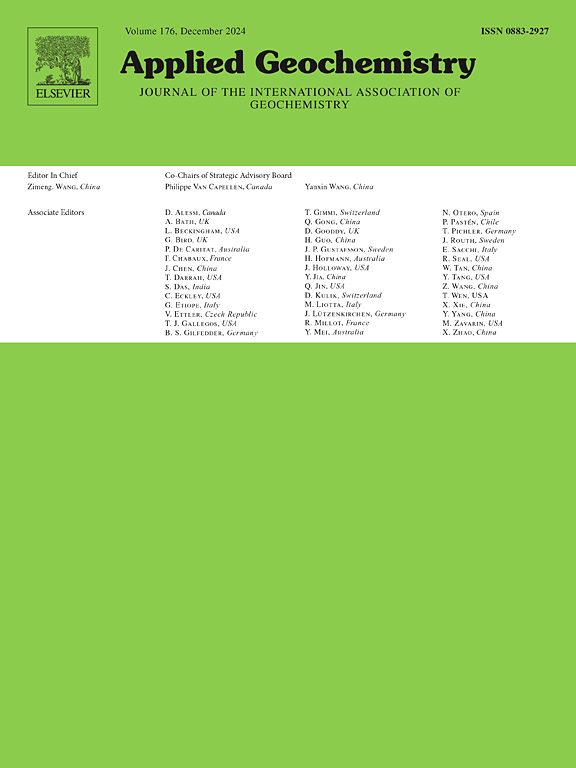Geochemical markers in the detection and identification of fossil fuels in waste material from an illegal landfill fire
IF 3.1
3区 地球科学
Q1 GEOCHEMISTRY & GEOPHYSICS
引用次数: 0
Abstract
Organic compounds, including n-alkanes, steranes, pentacyclic triterpanes, polycyclic aromatic hydrocarbons (PAHs), and alkyl aromatic hydrocarbons, often originate from industrial activities, vehicle emissions, used transformer oils, biomass combustion, and also natural organic matter. The unprotected surroundings of former industrial sites, especially those affected by fire, pose significant risks to public health and the environment, particularly soil and water. These compounds are also excellent geochemical markers for determining the material that was used to ignite the fire, including petroleum products, oils, greases, and gasoline. This study presents research findings from an illegal landfill in Sosnowiec, Poland, which caught fire in 2020, leading to the combustion of petroleum substances, plastics, and other waste. The study found PAHsum concentrations ranging from 4.57 to 302.45 ppm in soil samples and from 3.04 to 27211.98 ppm in burnt solid waste samples, indicating significant contamination. The test results confirmed that the main sources of these pollutants in the analyzed research area were, among other things, greases, industrial oils, products from solid fuel processing, and coal waste. The use of pentacyclic triterpanes (hopanes and moretanes) seems to be the most effective diagnostic method to detect the presence of organic fossil fuels in waste samples. This research underscores the critical need to monitor and control illegal landfills to prevent fires and limit the exposure of communities and the environment to toxic pollutants. The methodologies applied here could be adopted globally to address soil and water pollution in similar contexts. By using these techniques, researchers could better interpret and manage environmental data, ultimately improving pollution control strategies worldwide.
检测和识别非法垃圾填埋场火灾废料中化石燃料的地球化学标记
有机化合物,包括正烷烃、甾烷烃、五环三聚烷烃、多环芳烃 (PAH) 和烷基芳烃,通常来源于工业活动、汽车尾气排放、使用过的变压器油、生物质燃烧以及天然有机物。前工业遗址周围未受保护的环境,尤其是受火灾影响的环境,对公众健康和环境,特别是土壤和水构成了重大风险。这些化合物也是极好的地球化学标记,可用于确定点燃火灾的材料,包括石油产品、油、油脂和汽油。本研究介绍了对波兰索斯诺维茨一个非法垃圾填埋场的研究结果,该垃圾填埋场于 2020 年起火,导致石油物质、塑料和其他废物燃烧。研究发现,土壤样本中多环芳烃的浓度从 4.57 到 302.45 ppm 不等,焚烧过的固体废物样本中多环芳烃的浓度从 3.04 到 27211.98 ppm 不等,表明污染严重。检测结果证实,这些污染物在分析研究区域的主要来源是油脂、工业用油、固体燃料加工产品和煤炭废料等。使用五环三聚烷烃(hopanes 和 moretanes)似乎是检测废物样本中是否存在有机化石燃料的最有效诊断方法。这项研究强调了监测和控制非法垃圾填埋场以防止火灾并限制社区和环境接触有毒污染物的迫切需要。这里应用的方法可在全球范围内采用,以解决类似情况下的土壤和水污染问题。通过使用这些技术,研究人员可以更好地解释和管理环境数据,最终改善全球的污染控制策略。
本文章由计算机程序翻译,如有差异,请以英文原文为准。
求助全文
约1分钟内获得全文
求助全文
来源期刊

Applied Geochemistry
地学-地球化学与地球物理
CiteScore
6.10
自引率
8.80%
发文量
272
审稿时长
65 days
期刊介绍:
Applied Geochemistry is an international journal devoted to publication of original research papers, rapid research communications and selected review papers in geochemistry and urban geochemistry which have some practical application to an aspect of human endeavour, such as the preservation of the environment, health, waste disposal and the search for resources. Papers on applications of inorganic, organic and isotope geochemistry and geochemical processes are therefore welcome provided they meet the main criterion. Spatial and temporal monitoring case studies are only of interest to our international readership if they present new ideas of broad application.
Topics covered include: (1) Environmental geochemistry (including natural and anthropogenic aspects, and protection and remediation strategies); (2) Hydrogeochemistry (surface and groundwater); (3) Medical (urban) geochemistry; (4) The search for energy resources (in particular unconventional oil and gas or emerging metal resources); (5) Energy exploitation (in particular geothermal energy and CCS); (6) Upgrading of energy and mineral resources where there is a direct geochemical application; and (7) Waste disposal, including nuclear waste disposal.
 求助内容:
求助内容: 应助结果提醒方式:
应助结果提醒方式:


